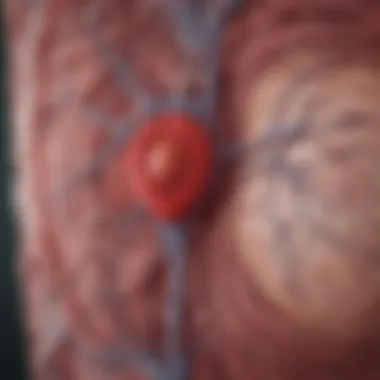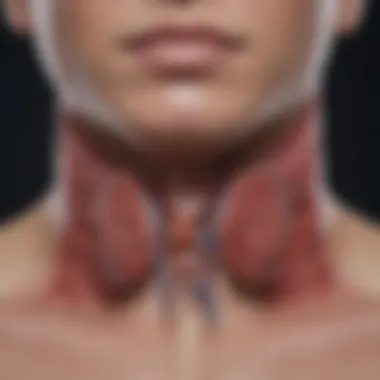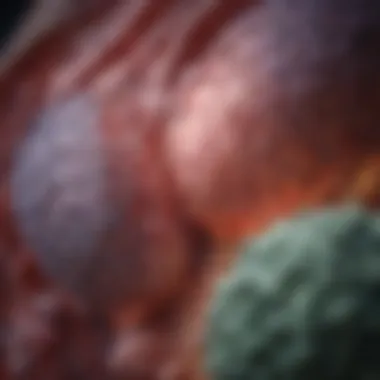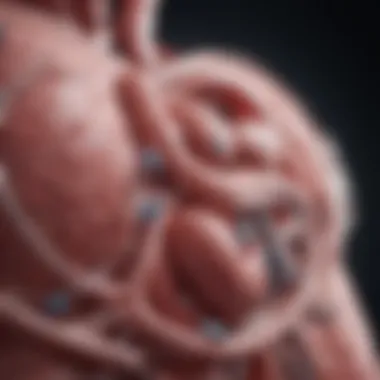Understanding Severe Pulmonary Artery Hypertension


Intro
Severe pulmonary artery hypertension (PAH) is a complex condition that poses significant challenges for both patients and healthcare providers. It encompasses a broad spectrum of symptoms and complications that profoundly affect quality of life. Understanding its pathophysiology, clinical features, and treatment options is crucial for effective management.
This article will delve into various aspects of severe PAH, offering insights that are relevant to students, researchers, educators, and professionals in the field of cardiopulmonary health.
Research Overview
Summary of Key Findings
Recent studies indicate that severe pulmonary artery hypertension is becoming more prevalent. Research highlights that earlier diagnosis and advancements in treatment options have improved management strategies. Moreover, emerging therapies show promise in enhancing patient outcomes.
"Understanding the underlying mechanisms of severe PAH can lead to more targeted therapies, potentially improving prognosis for patients."
Research Objectives and Hypotheses
The primary objective of this research is to uncover the multifaceted nature of PAH and the therapeutic interventions that can mitigate its effects. Hypotheses guided by recent findings include:
- An increase in early diagnosis can lead to reduced morbidity in patients.
- Targeted therapy may enhance vascular function and decrease progression of the disease.
- Comprehensive patient education contributes to improved treatment adherence.
Methodology
Study Design and Approach
This research employs a mixed-methods approach, integrating quantitative data from clinical trials with qualitative insights gathered from patient interviews. This design allows for a holistic view of the impact of severe PAH.
Data Collection Techniques
Data collection includes:
- Clinical trial data on treatment efficacy and outcomes.
- Patient surveys assessing quality of life and symptom severity.
- Interviews with healthcare providers to gain perspectives on treatment challenges and successes.
This methodology enables a thorough understanding of severe pulmonary artery hypertension and its implications for patient care.
Prelude to Severe Pulmonary Artery Hypertension
Severe pulmonary artery hypertension (PAH) represents a significant health concern with serious implications for patient well-being and healthcare systems. The systematic understanding of this condition is crucial for health professionals, researchers, and policymakers. It demands attention because of its insidious onset, complex pathophysiology, and the challenge it poses for timely diagnosis and effective treatment. This article aims to provide a deep examination of severe PAH, elucidating it through various lenses such as definition, epidemiology, pathophysiology, clinical presentation, and treatments.
Definition and Importance of PAH
Pulmonary artery hypertension is defined as a progressive disorder characterized by high blood pressure in the pulmonary arteries. These are vessels that carry blood from the heart to the lungs. For a diagnosis of severe PAH, the mean pulmonary arterial pressure typically exceeds 25 mmHg at rest. This condition leads to the heart having to work harder to pump blood, leading to eventual right-sided heart failure if left untreated. Understanding PAH is crucial as it significantly impacts morbidity and mortality. The early identification and management of patients can lead to improved outcomes and better quality of life.
Epidemiology of Severe PAH
Epidemiological studies reveal that severe PAH is rare yet alarming. It affects individuals of various age groups, predominantly women in their middle years, but can also occur in men and children. The estimated prevalence ranges from 15 to 50 cases per million people globally. Understanding the patterns of this disease is critical, particularly identifying populations at risk, such as those with connective tissue diseases, congenital heart diseases, or a history of thrombosis.
In addition, the recognition of risk factors, including family history and certain medications, can help in early detection and prevention strategies. Authority in this field suggests a multidisciplinary approach is vital for proper management as it involves cardiologists, pulmonologists, and other specialists working in tandem.
Understanding the epidemiological landscape of severe PAH aids in developing targeted screening programs and creating awareness about this life-threatening condition.
Pathophysiology of Severe PAH
Understanding the pathophysiology of severe pulmonary artery hypertension (PAH) is essential for grasping how this condition manifests and progresses in patients. The disturbance in the normal function of blood vessels in the lungs leads to significant health repercussions. The basic mechanisms of disease involve complex interactions between multiple biological pathways. A detailed comprehension of these pathways aids in identifying interventions and potential therapeutic targets.
Vascular Remodeling and Pathways
In severe PAH, the pulmonary vasculature undergoes structural changes, commonly known as vascular remodeling. Changes in the vessel wall composition occur, leading to narrowing and obstruction of the pulmonary arteries. These alterations increase resistance to blood flow, resulting in elevated pulmonary artery pressures. Key factors involved in this remodeling include smooth muscle cell proliferation, extracellular matrix deposition, and changes in endothelial function. The activation of various pathways, such as the renin-angiotensin system and the endothelin pathway, played a significant role in this remodeling process.


"Vascular remodeling is a hallmark of severe PAH, contributing to the transition from compensated to decompensated heart failure."
The understanding of these pathways has important implications for treatment. Therapies aimed at reversing or halting vascular remodeling can alter disease outcomes.
Role of Vascular Endothelial Growth Factor
Vascular endothelial growth factor (VEGF) is a critical signal protein that plays a prominent role in angiogenesis and vascular permeability. In severe PAH, elevated levels of VEGF have been documented in patients. Dysregulation of VEGF may contribute to vascular changes observed in PAH. Increased vascular permeability leads to pulmonary edema and further exacerbates the condition. Targeting VEGF pathways can offer insights into potential therapies for PAH. Blocking excess VEGF may aid in normalizing vascular function and reducing fluid accumulation.
Impact of Inflammation and Coagulation
Inflammation is another critical element associated with severe PAH. Elevated inflammatory markers have been linked to the disease's progression. Inflammatory processes induce further injury to the pulmonary vascular endothelium, leading to thrombus formation and vascular obstruction. The coagulation cascade, often activated in severe PAH, further complicates the condition. Developing a better understanding of how inflammation and coagulation interact can help to design novel therapeutic interventions focused on reducing these adverse processes in the pulmonary artery, addressing both the symptoms and pathogenesis of the disease.
In summary, the pathophysiology of severe PAH is multifaceted, involving remodeling of the vasculature, the critical role of VEGF, and the influence of inflammatory and coagulation processes. A thorough understanding of these elements is crucial for developing effective treatments and management strategies.
Clinical Presentation of Severe PAH
The clinical presentation of severe pulmonary artery hypertension (PAH) is essential for timely diagnosis and management. Understanding the symptoms and classification allows healthcare professionals to identify patients who may require urgent evaluation and intervention. It also fosters better communication and education about the disease, enhancing the quality of patient care.
Common Symptoms and Signs
Severe PAH presents with various symptoms that typically escalate as the disease progresses. Recognizing these symptoms promptly is crucial.
- Dyspnea: Shortness of breath, especially during physical activity, is a primary indicator. Patients often report increased difficulty in performing routine tasks.
- Fatigue: This is a common but often overlooked symptom. Patients may experience a significant decline in energy levels, leading to a diminished quality of life.
- Chest Pain: Some individuals report chest discomfort. This symptom can be mistaken for other cardiac issues.
- Palpitations: An awareness of heartbeats, which can be both alarming and indicative of underlying pathology.
- Cyanosis: A bluish tint to the lips or skin may signal low oxygen levels, occurring in advanced cases.
- Edema: Swelling in the ankles and legs due to fluid retention can also occur.
It is pivotal to recognize that these signs can overlap with other medical conditions, which emphasizes the need for thorough clinical evaluation.
Clinical Classification of PAH
The classification of severe PAH helps in understanding its etiology and directing appropriate management strategies. The World Health Organization defines it in several groups based on causes, which consist mainly of:
- Group 1: Pulmonary Arterial Hypertension (PAH), due to conditions like idiopathic PAH, hereditary PAH, or associated with specific diseases.
- Group 2: PAH due to Left Heart Disease, often arising from heart failure or valvular heart disease.
- Group 3: PAH associated with Lung Diseases, including chronic obstructive pulmonary disease and interstitial lung disease.
- Group 4: Chronic Thromboembolic PAH (CTEPH), resulting from unresolved blood clots in the pulmonary arteries.
- Group 5: PAH with Unclear Mechanisms, a category that includes various systemic disorders.
This classification outlines the diverse origins of PAH, guiding diagnostic and therapeutic approaches based on the underlying cause. Proper understanding of these classifications helps clinicians in crafting individualized treatment plans.
It is vital for healthcare professionals to maintain awareness of the clinical presentation of severe PAH, as timely intervention can ultimately improve patient outcomes.
Diagnosis of Severe PAH
The diagnosis of severe pulmonary artery hypertension (PAH) is a critical step in managing and treating the condition effectively. Early and accurate diagnosis can significantly improve the outcomes for patients. A thorough understanding of the disease’s characteristics, symptomatology, and potential risk factors enhances the diagnostic process. Without precise diagnosis, patients may face a delay in receiving appropriate treatments, worsening their health status.
Initial Assessment and Risk Factors
The initial assessment of suspected severe PAH involves a comprehensive clinical evaluation. Healthcare providers begin by gathering a detailed medical history, focusing on symptoms such as dyspnea, fatigue, chest pain, or syncope. The assessment may also include a review of family history, as genetic predisposition can play a role in PAH's development.
Common risk factors that contribute to the development of PAH include:
- Connective tissue diseases: Such as scleroderma or lupus.
- Chronic lung diseases: Like obstructive pulmonary disease or interstitial lung disease.
- Congenital heart defects: Patients with these conditions are at higher risk.
- HIV infection: Linked to increased prevalence of PAH.
- Certain medications: Such as anorexigens or some chemotherapeutic agents.
Identifying these factors helps in determining the likelihood of developing severe PAH and aids in tailoring further diagnostic steps.
Diagnostic Imaging Techniques
Diagnostic imaging plays a vital role in confirming severe PAH and assessing its severity. Various imaging modalities can be employed:
- Echocardiography: This is often the first step in diagnosis. It helps evaluate right ventricular size and function and estimates pulmonary artery pressure.
- Magnetic Resonance Imaging (MRI): Offers detailed visualization of the heart and pulmonary arteries, often more accurate than echocardiography.
- Chest X-ray: This can help identify right ventricular enlargement and any underlying lung issues that may contribute to PAH.
These techniques not only aid in diagnosis but also help monitor disease progression over time.


Invasive Hemodynamic Assessment
Despite advances in non-invasive imaging, invasive hemodynamic assessment remains the gold standard for definitive diagnosis of severe PAH. This procedure involves catheterization to directly measure pressures within the pulmonary arteries.
- Right heart catheterization: This is the primary invasive method used to diagnose PAH. It provides precise measurements of pulmonary artery pressure, right atrial pressure, and pulmonary capillary wedge pressure, enabling the differentiation between pre-capillary and post-capillary causes of elevated pressures.
Through this assessment, clinicians can establish a clear diagnosis, determine severity, and formulate an appropriate treatment strategy.
Accurate diagnosis using these methods is crucial. Misdiagnosis or late diagnosis can lead to serious complications and reduced quality of life for patients.
Treatment Modalities for Severe PAH
Understanding the treatment modalities for severe pulmonary artery hypertension (PAH) is crucial for improving patient outcomes. This section highlights various approaches that aim to manage the condition effectively. Through a combination of pharmacological treatments, non-pharmacological interventions, and advanced procedures, clinicians can address the complexities of severe PAH.
Pharmacological Approaches
Pharmacological therapies are the cornerstone of PAH management. These medications target different pathways involved in the disease process.
- Endothelin Receptor Antagonists: Drugs like bosentan and ambrisentan help to relax the blood vessels in the lungs. They counteract the vasoconstrictive effects of endothelin, a potent vasoconstrictor implicated in PAH.
- Phosphodiesterase-5 Inhibitors: Sildenafil and tadalafil are well-known medications that enhance the effects of nitric oxide, leading to vasodilation and improved blood flow within the pulmonary arteries.
- Prostacyclin Analogues: Agents such as epoprostenol provide direct vasodilation and inhibit platelet aggregation, significantly improving exercise capacity and reducing symptoms.
Each of these pharmacological approaches comes with its unique profile in terms of efficacy and side effects. Close monitoring of patients is essential to optimize the treatment regimen.
Non-Pharmacological Interventions
In addition to drug therapy, non-pharmacological approaches play a significant role in the overall management of severe PAH. They provide supportive care and improve patient quality of life.
- Lifestyle Modifications: Patients are often advised to engage in moderate physical activity tailored to their capacity. This can help improve exercise tolerance and enhance overall well-being.
- Oxygen Therapy: In cases where oxygen saturation is low, supplemental oxygen can relieve symptoms and improve quality of life.
- Pulmonary Rehabilitation Programs: These programs offer a structured approach to increase physical activity levels while providing education about the disease and coping strategies.
Integrating these interventions can lead to improved patient outcomes, making them an essential component of comprehensive care.
Pulmonary Artery Enhancement Procedures
For patients with severe cases of PAH, more invasive interventions may be necessary. Pulmonary artery enhancement procedures focus on improving hemodynamics and relieving symptoms.
- Balloon Atrial Septostomy: This procedure creates a shunt between the right and left atria, effectively reducing pressure in the right heart and improving blood flow.
- Lung Transplantation: In selected patients with advanced PAH who do not respond to medical therapy, lung transplantation may offer a cure. This procedure carries risks but can significantly improve survival and quality of life.
- Transcatheter Pulmonary Artery Denervation: Though still under investigation, this technique aims to disrupt sympathetic nerve activity in the pulmonary artery, potentially leading to improved outcomes in PAH patients.
These procedures may provide significant benefit for patients who fail to respond adequately to standard treatments, underscoring the need for a tailored approach in managing severe PAH.
Effective treatment of severe PAH requires a combination of pharmacological, non-pharmacological, and procedural strategies tailored to individual patient needs. Regular follow-up and reassessment are vital for optimizing therapy.
In summary, treatment modalities for severe PAH are diverse and must be personalized to ensure the best outcomes. Each modality offers unique benefits, and understanding their roles can guide clinicians in their decision-making processes. This multidisciplinary approach promotes longevity and enhances the overall quality of life for patients suffering from this severe condition.
Long-Term Management and Follow-Up
Long-term management of severe pulmonary artery hypertension (PAH) is essential for improving patient outcomes and ensuring a higher quality of life. This approach demands ongoing monitoring, systematic adjustments in treatment, and active collaboration among healthcare professionals, patients, and caregivers. The chronic nature of PAH requires a dedicated strategy that addresses not only the physiological aspects of the disease but also the emotional and psychological factors affecting patients. The following sections will detail the critical components of long-term management in this context.
Monitoring Disease Progression
Monitoring disease progression is paramount in managing severe PAH effectively. Regular assessments allow clinicians to track changes in pulmonary pressures and identify potential complications early. Such monitoring often includes:
- Regular Follow-Up Appointments: Frequent visits to healthcare providers can help physicians assess the clinical status of the patient, discuss symptoms, and adjust treatment as needed.
- Imaging Techniques: Non-invasive imaging, such as echocardiograms or magnetic resonance imaging (MRI), provides insights into right ventricular function and hemodynamics. These tools can capture changes in the structure and function of the heart and pulmonary arteries.
- Functional Testing: Tests like the 6-minute walk test help gauge physical endurance and symptomatology. This can give clues about how well the patient is managing day-to-day activities.
- Laboratory Assessments: Blood tests can evaluate markers of heart function and possible complications such as liver congestion or renal impairment.
"Effective monitoring is a cornerstone in the long-term management of severe PAH, which allows for timely interventions and enhances patient quality of life."
Adjusting Treatment Plans
As PAH is a dynamic condition, adjusting treatment plans is crucial for optimal management. Each patient's response to therapy can vary significantly, necessitating tailored strategies. Key considerations in this process include:


- Evaluating Treatment Efficacy: Clinicians should regularly review the effectiveness of ongoing therapies. This involves analyzing symptom relief, exercise capacity, and any potential side effects.
- Medication Adjustments: Depending on the progression of the illness and patient responses, it may be necessary to switch medications or alter dosages. This ensures that patients receive the most effective treatments possible.
- Incorporating New Therapies: Advances in PAH pharmacotherapy may provide new options. Keeping up-to-date with the latest research is essential to decide which new treatments can be integrated into existing regimens.
- Considering Patient Preferences: Patients should be involved in discussions about their treatment. Understanding their preferences regarding lifestyle and treatment goals helps shape more personalized management plans.
Impact of Severe PAH on Quality of Life
Severe pulmonary artery hypertension (PAH) significantly affects the quality of life of patients. This section aims to shed light on how this disorder complicates daily living. Understanding these impacts can guide healthcare professionals in delivering better care and also help patients make informed decisions. The consequences of PAH extend beyond physical effects, presenting multifaceted challenges that necessitate added attention.
Physical Limitations and Symptoms
Severe PAH causes notable physical limitations. The elevation in pulmonary artery pressure means that the heart works harder to pump blood into the lungs. This can lead to several symptoms that compromise daily activities and overall well-being. Common symptoms include:
- Shortness of breath: This is often worse with exertion, making even simple tasks like walking difficult.
- Fatigue: Patients frequently experience extreme tiredness, which is not alleviated by rest.
- Chest pain: Discomfort or pain in the chest may occur, adding to the overall distress of patients.
- Swelling in the ankles or legs: This is due to fluid buildup. Many patients may find that their mobility is restricted due to compromised blood flow.
These symptoms can create a cycle of declining physical activity. As exercise capacity diminishes, patients may also experience increasing weakness and a sense of helplessness. Therefore, it is essential to prioritize symptom management and rehabilitation strategies that focus on improving physical function and encouraging activity according to individual capabilities.
Emotional and Psychological Effects
The emotional and psychological toll of severe PAH is profound. Chronic health conditions are often linked to mental health issues, and PAH is no exception. Here are a few of the emotional impacts commonly observed in patients:
- Anxiety: Patients may worry about symptoms worsening or potential health complications.
- Depression: The persistent physical limitations can lead to feelings of isolation and despair. Loss of social interactions due to limited physical activity can exacerbate these feelings.
- Fear: The unpredictability of the disease progression can instill a deep-seated fear concerning the future.
Managing these emotional responses is critical. Psychosocial support, whether through counseling or group therapy, provides patients and their families with coping strategies. Emphasizing emotional well-being is not an ancillary aspect of PAH treatment but rather a core component of comprehensive care.
"By addressing both physical and emotional needs, healthcare providers can significantly enhance the quality of life for individuals suffering from severe PAH."
Future Directions in Research
Research into severe pulmonary artery hypertension (PAH) holds the potential to significantly improve patient prognosis and quality of life. As the understanding of this complex disease evolves, innovating approaches and insights become essential. Focusing on areas such as novel therapeutic strategies and genetic factors can lead to breakthroughs that change how PAH is managed. Recognizing these future directions not only benefits researchers but ultimately enhances care for patients.
Innovative Therapies Under Investigation
Current therapies for severe PAH primarily aim to alleviate symptoms and extend survival. However, research is ongoing to discover innovative therapies that target underlying mechanisms of the disease. Some promising areas include:
- New pharmacological agents: Medications like selexipag target specific pathways to enhance vasodilation and reduce pulmonary pressure. Ongoing trials continue to explore their effectiveness with combination treatments.
- Gene therapies: Advancements in gene editing, particularly CRISPR technology, show potential in correcting genetic anomalies that contribute to PAH.
- Regenerative medicine: Stem cell therapies are being researched to restore dysfunctional pulmonary vasculature. Findings from these studies could lead to significant improvements in patient outcomes.
These innovative therapies represent a shift in understanding PAH beyond palliative measures. With ongoing clinical trials and a focus on translational research, the landscape of treatment could evolve considerably within the next decade.
Potential Genetic Factors Contributing to PAH
Genetics plays a pivotal role in the susceptibility and progression of severe PAH. Identifying specific genetic markers could revolutionize diagnosis and treatment approaches. Key areas of investigation include:
- Hereditary PAH: Mutations in genes such as BMPR2 have been linked to familial forms of PAH. Research into these genetic underpinnings may lead to risk assessment tools and personalized therapies.
- Polymorphisms: Other variations in genes related to vascular function and inflammatory responses could influence individual risk. Understanding these factors can improve screening and preventive strategies.
- Environmental interactions: How genetic predispositions interact with environmental factors, such as toxins or lifestyle, remains a significant research avenue. This knowledge could inform better therapeutic targets and intervention strategies.
"The landscape of pulmonary arterial hypertension research is changing rapidly, unveiling new potential pathways to improve patient outcomes and ultimately save lives."
Patient-centered research will ensure that these findings lead to tangible benefits, enhancing the well-being of those affected by severe PAH.
Ending
Severe pulmonary artery hypertension (PAH) presents substantial challenges not only for patients but also for healthcare systems. The importance of concluding this discussion on severe PAH lies in consolidating knowledge and enhancing understanding of this complex condition. As healthcare specialists, educators, and researchers navigate through this diverse terrain, key takeaways reinforce the essential elements of management and ongoing research.
Summary of Key Points
In summary, the article underscores the following crucial points regarding severe pulmonary artery hypertension:
- Definition and Impact: Severe PAH is characterized by elevated pressure in the pulmonary arteries, leading to significant morbidity and mortality.
- Pathophysiology: The condition involves complex interactions between vascular remodeling, inflammation, and coagulation pathways.
- Clinical Presentation: Symptoms can range from exertional breathlessness to fatigue, and provide critical insights into diagnosis and classification strategies.
- Diagnostic Approaches: Comprehensive evaluation through imaging and hemodynamic assessments is vital for accurate diagnosis.
- Treatment Modalities: Both pharmacological and non-pharmacological strategies are essential for managing PAH, highlighting the importance of individualized treatment plans.
- Quality of Life: The impact of severe PAH extends beyond physical limitations, significantly affecting emotional and psychosocial well-being.
- Future Directions: Ongoing research into innovative therapies and genetic factors may pave the way for improved treatment outcomes and understanding of PAH.
The Importance of Continued Research and Awareness
Ongoing research in the field of severe pulmonary artery hypertension is paramount. Expanding scientific inquiry leads to greater specificity in diagnostic tools and intervention strategies. The complexity of the disease necessitates a multi-disciplinary approach to treatment, ensuring that healthcare professionals remain informed on the latest research developments.
Raising awareness about severe PAH within medical communities and among the public can empower patients and promote early diagnosis and treatment. Investing in educational programs can further enhance understanding, ultimately offering patients more hope for improved quality of life.
"Continued research and awareness are critical to advancing the management of severe pulmonary artery hypertension and improving patient outcomes."















